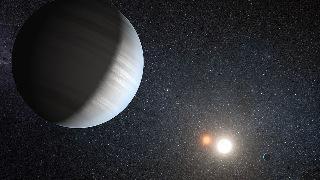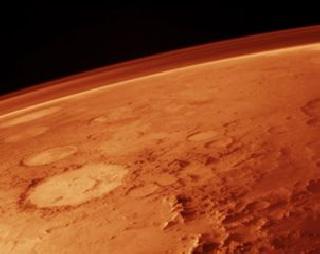
Artist's impression of Kepler-47c which is a Neptune-sized planet that orbits a binary star at a comfortable distance where an Earth-sized moon can be potentially habitable. Photo: NASA/JPL-Caltech/T. Pyle
NEW YORK (PTI): Habitable environments could be less common in the universe than previously thought, say scientists, after they found that alien moons around distant worlds may not be able to support life.
The exomoons may not possess magnetic fields strong enough to protect extraterrestrial life from radiation that may blast it from deep space and nearby stars, researchers said.
Past discoveries of many giant alien planets that sit closer to their stars than Mercury does to the Sun hints that exomoons could indeed lie within habitable zones, 'SPACE.com' reported.
However, as large as exomoons could get, models of their formation suggest they could never get near the mass of Earth.
Due to this size limitation, exomoons probably cannot form magnetic fields of their own powerful enough to shield any life on them from cosmic rays emerging from deep space or intense radiation flowing at them from their parent stars.
However, scientists wanted to explore the possibility of exomoons having another magnetic field source, which might emanate from the giant planets they would orbit.
These planets are surrounded by magnetospheres, bubbles of plasma created by stellar winds crashing into the magnetic fields of planets.
Scientists modelled planets similar to Neptune, Saturn and Jupiter in the habitable zone of a sun-like star with moons the mass and diameter of Mars orbiting them.
They discovered that exomoons would generally only be shielded by their planets' magnetospheres if they lay outside habitable zones. In other words, these exomoons could be in habitable zones or be magnetically shielded, but not both.
"Habitable environments could be less common in the universe that previously thought," said study author Jorge Zuluaga, an astronomer at the University of Antioquia in Colombia.
However, exomoons could still be shielded if the giant planets they orbit differ in composition from those in our solar system.
For example, a Neptune-like planet that was composed almost completely of heavy elements instead of having almost half of its mass in hydrogen like Neptune would have some chance of defending habitable moons.
"We have just scratched the tip of the iceberg, and there are other factors to consider and study in depth," Zuluaga said.
"We need to discover the first exomoon and detect the first magnetic fields of extrasolar giant planets to gather some observational support to our findings," he said.
 Previous Article
Previous Article Next Article
Next Article













The Indian Air Force, in its flight trials evaluation report submitted before the Defence Ministry l..
view articleAn insight into the Medium Multi-Role Combat Aircraft competition...
view articleSky enthusiasts can now spot the International Space Station (ISS) commanded by Indian-American astr..
view article